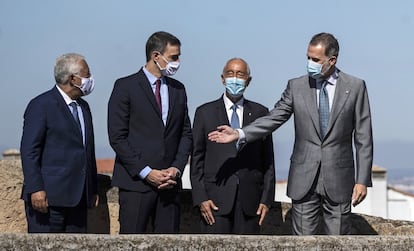Spain reopens border with Portugal after three-month closure due to coronavirus
The move comes after the EU began to reopen its borders to 14 countries that have been approved by member states

The border between Spain and Portugal was officially reopened on Wednesday in a ceremony led by Spain’s King Felipe VI and the president of Portugal, Marcelo Rebelo de Sousa. The Spain-Portugal border, which is informally known as “la raya,”or the line, was closed for an unprecedented three and a half months due to the coronavirus crisis, which led to the imposition of strict travel restrictions. Its reopening is a symbolic sign that the worst of the crisis is now over.
Both Spain and Portugal, however, continue to record new outbreaks of the coronavirus. In Spain, there are around 50 active outbreaks, all of which are considered under control; and in Portugal, parts of Greater Lisbon have reintroduced lockdown restrictions following a spike in cases.
The border opening between two countries is not a threat, but rather an opportunity for common developmentPortuguese Prime Minister António Costa
Before the ceremony, Spanish Prime Minister Pedro Sánchez apologized to his Portuguese counterpart António Costa for having to maintain his distance. “Sorry António, but I can’t give you a hug,” he said to the Portuguese prime minister, who like Sánchez, belongs to a socialist party. King Felipe also apologized to De Sousa for not being able to shake his hand.
“The border opening between our two countries is not a threat, but rather an opportunity for common development,” said Costa. “We all have to be very clear that until there is a vaccine we are going to have to live with Covid. That is the reality for Spain, Portugal and the rest of the world.”
The first act took place in the Spanish city of Badajoz, inside its old Moorish citadel, the Alcazaba, where people had gathered to cheer in support of the monarchy. Protesters, however, were also present and called for “royal spending for schools and hospitals.” This act was followed by a ceremony at the castle of Elvas in Portugal.
Portugal and Spain introduced extraordinary measures to curb coronavirus contagion at almost the same time. But while Portugal imposed a state of emergency before recording a single death, in Spain, 535 people had died from Covid-19 by the time the state of alarm was introduced.
Portugal has been one of the countries which has best controlled the spread of the coronavirus, and the closure of its borders with Spain has played an important part of its strategy. Indeed, Portugal has taken the most cautious approach to reopening its borders of all countries in the European Union. While EU countries began opening up their borders from June 21, Portugal decided to wait until July 1 in a bid to reduce outbreaks.
The reopening of the Spain-Portugal border comes in time for the summer holiday period, when many Spanish tourists travel to beaches in the neighboring country for vacation.
Safety measures
Spain will ask all tourists to complete health forms before traveling to the country in order to make it easier to locate their contacts in the case of a contagion. That’s according to an order published in the Official State Gazette (BOE) on Wednesday. These forms will ask travelers for their contact address in Spain, previous travel experiences, and whether they are suffering from coronavirus-related symptoms in a bid to prevent imported cases. The order also stipulates that travelers will be subject to document and temperature controls when they arrive in Spain.
The new order comes after the European Council formerly agreed on Tuesday to an initial “safe list” of 14 countries from which they will allow non-essential travel from July. The countries are Algeria, Australia, Canada, Georgia, Japan, Montenegro, Morocco, New Zealand, Rwanda, Serbia, South Korea, Thailand, Tunisia and Uruguay. China will also be included if it reciprocates by allowing in EU travelers.
The document is intended as a recommendation to ensure that EU members only allow the entry of residents from countries considered safe and promise not to unilaterally authorize entry from a nation that is not on the list.
The list will be updated every two weeks to either add or remove countries based on their epidemiological situation. The Italian government, however, has indicated that it will maintain strict restrictions on travelers from outside the EU.
With borders opening, Spain’s airport authority AENA announced that it had 1,482 flights scheduled for Wednesday – 743 arrivals and 739 departures. This is a sharp drop from last year’s figures, when 6,500 flights were scheduled for the same day.
English version by Melissa Kitson.
Tu suscripción se está usando en otro dispositivo
¿Quieres añadir otro usuario a tu suscripción?
Si continúas leyendo en este dispositivo, no se podrá leer en el otro.
FlechaTu suscripción se está usando en otro dispositivo y solo puedes acceder a EL PAÍS desde un dispositivo a la vez.
Si quieres compartir tu cuenta, cambia tu suscripción a la modalidad Premium, así podrás añadir otro usuario. Cada uno accederá con su propia cuenta de email, lo que os permitirá personalizar vuestra experiencia en EL PAÍS.
¿Tienes una suscripción de empresa? Accede aquí para contratar más cuentas.
En el caso de no saber quién está usando tu cuenta, te recomendamos cambiar tu contraseña aquí.
Si decides continuar compartiendo tu cuenta, este mensaje se mostrará en tu dispositivo y en el de la otra persona que está usando tu cuenta de forma indefinida, afectando a tu experiencia de lectura. Puedes consultar aquí los términos y condiciones de la suscripción digital.
More information
Últimas noticias
There is as much life left to discover on planet Earth as that which is already known
Dozens presumed dead, around 100 injured in fire at Swiss Alps bar during New Year’s celebration
Is porn for women different from conventional porn? We spoke to those who make it
Cartagena de Indias is sinking: What can the city do to mitigate it?
Most viewed
- Reinhard Genzel, Nobel laureate in physics: ‘One-minute videos will never give you the truth’
- David King, chemist: ‘There are scientists studying how to cool the planet; nobody should stop these experiments from happening’
- Sinaloa Cartel war is taking its toll on Los Chapitos
- Oona Chaplin: ‘I told James Cameron that I was living in a treehouse and starting a permaculture project with a friend’
- The Interoceanic Train, the Mexican alternative to the Panama Canal










































